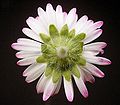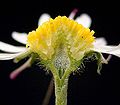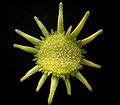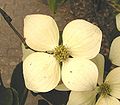Pseudanthium
A pseudanthium (Greek "false flower") is a special form of inflorescence in which several small, greatly reduced flowers are grouped together to form a new, flower-like structure, a false flower or superflower. Below the individual flowers is the receptacle, the receptacle (clinanthium, phoranthium) of the individual flowers, which together form the corolla (calathium, anthodium). Below these are bracts (phyllaries, involucral leaves), which may be free or fused. In their entirety, they are called the involucrum (involucrum; Latin: "sheathing"). This involucrum can contribute to the scooping function of the pseudanthium, e.g. in Cornus kousa or the golden thistles (Carlina).
Pseudanthia are a major characteristic of the large flowering plant family Asteraceae. In the largest subfamily, the Asteroideae, to which the daisy and the sunflower belong, mostly zygomorphic marginal flowers, mostly ray florets, provide the show apparatus, while centrally the usually radially symmetrical tubular florets sit. Also known are the pseudoflowered fruiting units of figs, here the fleshy and pitcher-shaped receptacle is formed into a syconium (hypanthodium) in which the flowers are located, related is the flat coenanthium of Dorstenia.
· 
Pseudanthium of the daisy (Bellis perennis) in rear view: the bracts form a plate-shaped involucrum
· 
Longitudinal section through a pseudanthium of Bellis perennis with recognizable single flowers
· 
Pseudanthium of Dorstenia hildebrandtii with radiating bracts
· 
Pseudanthium of the Asian flowering dogwood (Cornus kousa) with four corolla-like bracts.
Pseudanthia are found in the following families.
See also
- Meranthium
- Cyathium
Questions and Answers
Q: What is a pseudanthium?
A: A pseudanthium is a special type of inflorescence where many flowers are grouped together to form a flower-like structure.
Q: What are the real flowers in a pseudanthium called?
A: The real flowers in a pseudanthium are called "florets."
Q: What family of plants are pseudanthia characteristic of?
A: Pseudanthia are characteristic of the daisy and sunflower family (Asteraceae or Compositae).
Q: What are the two types of flowers found in a pseudanthium?
A: The two types of flowers found in a pseudanthium are ray flowers and disk flowers.
Q: What is unique about the sytem of a pseudanthium?
A: The system of a pseudanthium is unique to the daisy and sunflower family in which either ray or disk flowers can be absent in some species.
Q: What is the advantage of a pseudanthium?
A: The advantage of a pseudanthium is that it produces far more seeds than a normal flower, but needs only one act of pollination.
Q: Does a pseudanthium represent an evolution of the inflorescence to a reproductive unit that may function in pollination like a single flower?
A: Yes, a pseudanthium represents an evolution of the inflorescence to a reproductive unit that may function in pollination like a single flower, at least in plants that are animal pollinated.
Search within the encyclopedia